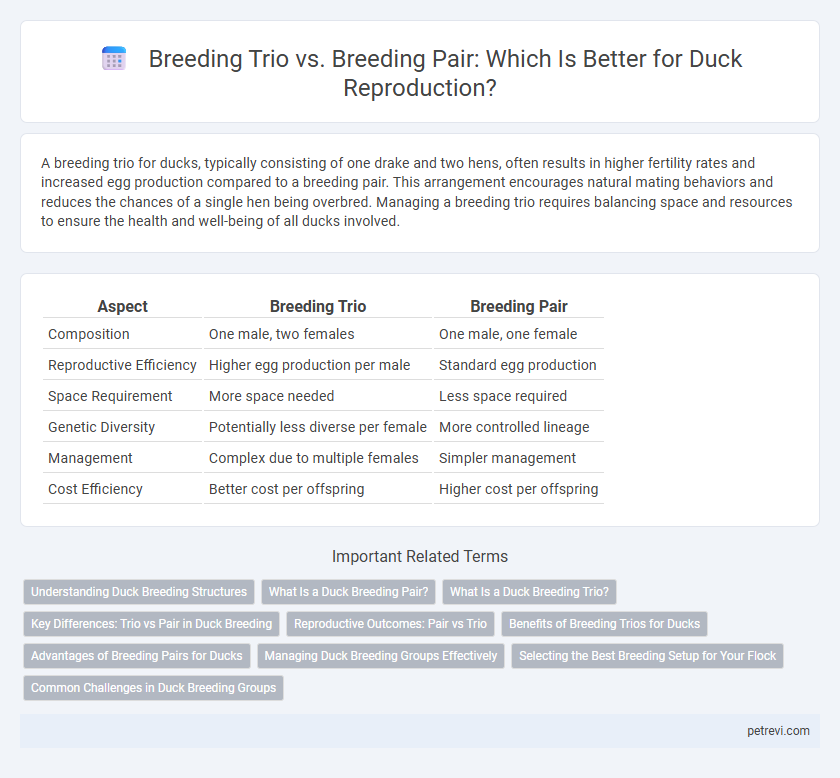A breeding trio for ducks, typically consisting of one drake and two hens, often results in higher fertility rates and increased egg production compared to a breeding pair. This arrangement encourages natural mating behaviors and reduces the chances of a single hen being overbred. Managing a breeding trio requires balancing space and resources to ensure the health and well-being of all ducks involved.
Table of Comparison
| Aspect | Breeding Trio | Breeding Pair |
|---|---|---|
| Composition | One male, two females | One male, one female |
| Reproductive Efficiency | Higher egg production per male | Standard egg production |
| Space Requirement | More space needed | Less space required |
| Genetic Diversity | Potentially less diverse per female | More controlled lineage |
| Management | Complex due to multiple females | Simpler management |
| Cost Efficiency | Better cost per offspring | Higher cost per offspring |
Understanding Duck Breeding Structures
A breeding trio in duck reproduction consists of one drake (male) paired with two hens (females), enhancing genetic diversity and increasing egg production compared to a traditional breeding pair. This structure optimizes reproductive efficiency by balancing male-to-female ratios, reducing competition among drakes and improving fertility rates. Effective management of breeding trios requires careful monitoring to prevent hen aggression and ensure consistent fertility across the flock.
What Is a Duck Breeding Pair?
A duck breeding pair consists of one male (drake) and one female (hen) kept together for natural mating and reproduction. This setup optimizes genetic diversity and parent-offspring bonding, resulting in higher hatch rates and healthier ducklings. Unlike a breeding trio, a pair reduces competition and stress, promoting more effective breeding behavior.
What Is a Duck Breeding Trio?
A duck breeding trio consists of one male and two female ducks housed together to increase the likelihood of successful fertilization and egg production. This setup optimizes mating opportunities and genetic diversity, often resulting in higher hatch rates compared to a breeding pair, which includes only one male and one female. Breeders choose a trio to balance the social dynamics of ducks while maximizing reproductive efficiency.
Key Differences: Trio vs Pair in Duck Breeding
A breeding trio for duck reproduction consists of two females and one male, increasing fertilization rates compared to a breeding pair, which includes only one male and one female. Trios often result in higher egg production and better genetic diversity, while pairs allow for easier management and reduce the risk of male aggression. The choice between a breeding trio and pair depends on the goals of maximizing output versus simplicity in care and space requirements.
Reproductive Outcomes: Pair vs Trio
Breeding trios in duck reproduction often yield higher egg fertility rates compared to breeding pairs, as the presence of an additional drake increases mating opportunities and genetic diversity. However, trios may introduce increased competition and aggression among drakes, potentially affecting hen welfare and egg production consistency. Studies show that while trios can enhance hatchability percentages, managing social dynamics is crucial to optimize reproductive outcomes in duck breeding programs.
Benefits of Breeding Trios for Ducks
Breeding trios in ducks enhance genetic diversity by introducing one drake to two females, reducing the risk of inbreeding and increasing the likelihood of fertile eggs. This arrangement supports higher egg production rates as two females can lay eggs simultaneously, maximizing reproductive output in a single breeding cycle. Managing trios also improves social dynamics by balancing male dominance behaviors, which can lead to healthier, less stressed flocks.
Advantages of Breeding Pairs for Ducks
Breeding pairs for ducks offer greater genetic control and simplicity in managing lineage compared to breeding trios, reducing the risk of inbreeding and ensuring offspring quality. Managing one male and one female minimizes aggression and competition among males, leading to less stress and higher fertility rates in the female. This setup also simplifies record-keeping and pairing selection, optimizing reproductive success and duckling survival rates.
Managing Duck Breeding Groups Effectively
Managing duck breeding groups effectively involves balancing genetic diversity and productivity, where a breeding trio--one male with two females--often improves fertility rates and reduces male aggression compared to a breeding pair. A breeding trio can increase egg production by allowing the male to mate with multiple females, optimizing reproduction without overcrowding. Monitoring bird behavior and health closely in both setups ensures sustainable breeding and minimizes stress within the flock.
Selecting the Best Breeding Setup for Your Flock
A breeding trio, consisting of one drake and two hens, often increases fertilization rates and hatchling numbers compared to a breeding pair, providing genetic diversity and reducing the risk of infertility in duck reproduction. Selecting the best breeding setup depends on factors such as flock size, species, and management goals; trios are ideal for maximizing egg production in small-to-medium flocks, while pairs can offer easier monitoring and reduced aggression. Evaluating the specific needs of your ducks and habitat conditions ensures optimal reproductive success and flock health.
Common Challenges in Duck Breeding Groups
Breeding trios often face challenges such as increased aggression and competition among males, which can lead to territorial disputes and stress that negatively impact egg production. In contrast, breeding pairs minimize conflict but may limit genetic diversity and reduce the number of fertilized eggs during breeding seasons. Managing space, ensuring adequate resources, and monitoring behavior are critical to overcoming common obstacles in duck breeding groups.
Breeding Trio vs Breeding Pair for Duck reproduction Infographic

 petrevi.com
petrevi.com